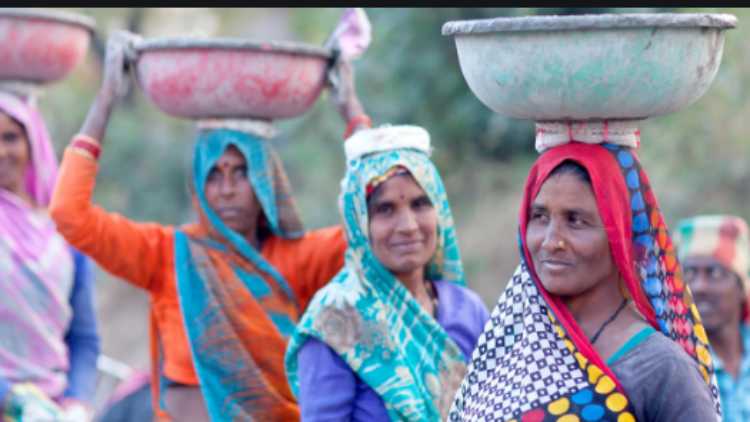
 Sushma Ramachandran
Sushma Ramachandran
Women’s Day has passed by with its usual share of events and hoopla to bring a focus on gender equality in all aspects of life. This is a day to pause and recall where women in this country have reached in their journey to be equal partners in development. One of the areas where women are still lagging behind, or in a sense, remain invisible, is in the sphere of business and the economy. Industrial units are swarming with women workers, farms are being cultivated by women and companies are being started by women entrepreneurs in this country. Yet there is little presence of these women in the public eye as men take centre stage whether it is industrial unions, farmers associations or industry chambers.
What is even more worrying is that the share of female workers in the numbers of the employed has been declining in recent years, prompting many questions over this unusual phenomena. India’ share of female labour force participation (FLFP) was 30.3 per cent in 1990 but fell to 20.5 per cent by 2020, according to World Bank estimates. The male labour force participation on the other hand, over the same period, declined only from 84 to 76.08 per cent.
In Asia our FLFP rate is the worst, even lower than in Pakistan or Afghanistan. One reason could be greater time spent on education now or growing employment in the informal sector which tends to be unrecorded. Even so, greater research needs to be done on this issue to determine the exact reasons for the decline of women in the labour force over the past 30 years.
The situation has worsened ever since the pandemic and the lockdown in March last year. The Centre for Monitoring Indian Economy (CMIE) found that the urban FLFP fell to 6.9 per cent in November 2020, the lowest rate since the data was first computed in 2016. It said the trend was unexpected given that urban women are more educated and there are better job opportunities in urban areas.
There is equally depressing data as far as unemployment is concerned for women. Prior to the pandemic, the rate of unemployment was 7 per cent for men but as high as 18 per cent for women, according to a study carried out by Google and Bain. By December 2020, the situation remained roughly the same at 17 per cent for women and 6 per cent for men but the extent of job losses is estimated to have been much higher for women than for men during the pandemic.
Looking at the role of women in specific sectors, one must examine agriculture first as here women have played a pivotal role for centuries. They have traditionally done much of the same back-breaking work as men but with the addition of household chores. Yet there is always a perception that only men do the bulk of farming work. Even the farmers’ agitation on the borders of Delhi, had to mark the presence of women farmers by a special show of strength on Women’s Day.
The one day display does not, however, improve the scenario in rural areas where there is a clear gender disparity in ownership of land-holdings. According to the Economic Survey of 2017-18, only 12.8 per cent of operational holdings are owned by women and even of these, 25.7 per cent come in the category of small and marginal holdings.
This is despite the fact that the Survey talks about the “feminization” of agriculture owing to growing migration to urban areas by men. This has led to women taking on multiple roles as cultivators, entrepreneurs and labourers. In fact, it is felt that given women greater access to resources like land, water, credit, technology and training will be the key to improving agricultural productivity. And it is conceded that not only is there is a differential gender-based approach towards providing such resources but there is a need to “mainstream” women in agriculture. On the plus side, the government has flagged these issues in the Survey itself and is trying to formulate policies to provide greater support to the woman farmer.
In the industrial sector as well, women remain sidelined in many ways. Unions only pay lip service to the presence of women members. The special needs of women are rarely taken up as issues during wage negotiations. The requirements of subsidized child care, creches and special health needs are taken up only sporadically and without much enthusiasm. Even the government’s decision to extend maternity leave to six months for the private sector in 2017 was described as being detrimental to women. Apparently, it was felt it would become the basis to deny jobs on the grounds that it would be difficult to provide such a long period of leave to private-sector women employees. In fact, it is the lack of such support that forces women to leave their jobs and ultimately leads to lower female participation in the labour force. It is interesting that there is no such perception about higher benefits preventing the hiring of women in Scandinavian countries and Europe where much longer maternity leave is being provided.
On the positive side, women have been playing a big role in some key sectors like banking where they have broken many glass ceilings. Similarly, younger women have been involved in creating many start-up ventures that are now doing exceedingly well. Nykaa, for instance, has become a unicorn, making its founder Falguni Nayar a billionaire. Slowly Indian women startup founders are evolving into major players in an arena dominated till now by men. In fact, a Reserve Bank of India study shows that only 5.9 per cent of startups were led solely by female founders in 2018-19.
Apart from Nykaa, other popular startups that have matured into big business ventures are Zilingo founded by Ankiti Bose, Mobikwik co-founded by Upasana Taku, ShopClues co-founded by Radhika Ghai Aggarwal and Zivame founded by Richa Kar. Thus it is clear the self-made woman billionaire list is no longer going to be dominated by well-know persons like Kiran Mazumdar Shaw in future.
The space for women is widening rapidly in all spheres of activity. Despite some of the worrying statistics, the fact is more women than ever before are educated now and skilled in high tech areas. What is now important is that policies be framed to ensure that those who are at the bottom of the pyramid are enabled to reach their full potential in the years ahead.
